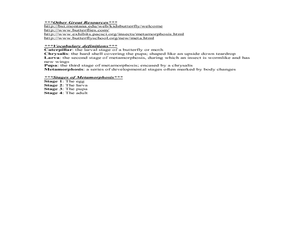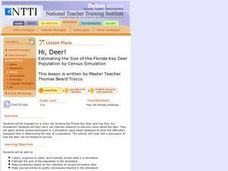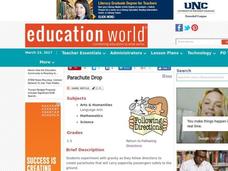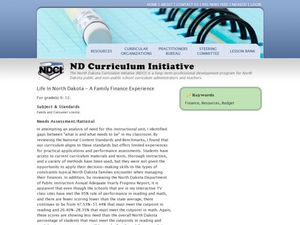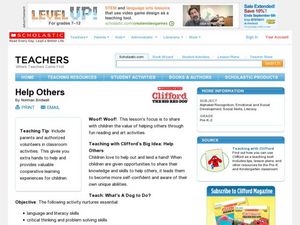Polar Trec
Down to the Deep Virtual Lab
At a depth of 3,000 m in the ocean, the pressure is 300 times that at sea level! In the activity, individuals predict what will happen to Styrofoam cups submerged 3,000 meters into the ocean. They then convert these units to soccer...
Curated OER
Cutting Expenses
Learners explore budgeting. In this finance and math lesson, students brainstorm ways in which households could save money. Learners view websites that give cost reducing ideas. Students complete an expense comparison chart and use the...
Moorea Coral Reef Long-Term Ecological Research Program
Paper Plate Fishes
Tropical fish make great art projects! Use paper plates to design, color, and assemble round and oval-shaped fish based on photographs of actual fish found along the Moorea Coral Reef. Kids learn about different fins- including the...
Curated OER
It's a Mystery to Me
Students read a variety of mysteries to improve their reading and comprehension skills. Using a worksheet, they define and practice using new vocabulary. In groups, they read stories from Poe and Sir Arthur Conan Doyle and write an...
Curated OER
Abuela's Weave Teacher's Guide
Students read and response to the book, Abuela's Weave. In this African-American literature activity, students discuss pre-reading questions, that focus on family traditions and make predictions about the text. Students read the text and...
Curated OER
Create a Computer Story
Second graders will create their own story and read it aloud. In this literacy/technology lesson, 2nd graders use computer software to create their own story, which is read back to them while they write it. Afterward, the student should...
Curated OER
Valentine Candy Count
Young scholars analyze a bag of Valentine candy to create a graph. In this graphing lesson, students make predictions, sort by color, record data and make a graph. Young scholars discuss results and make generalizations. Students...
Curated OER
Memories, A Connection to the Past
Students read four or more books. They make predictions before reading, complete a picture walk, read in partners and complete graphic organizers. Various graphic organizers are provided in English and Spanish.
Curated OER
Life Cycle of the Monarch Butterfly
Third graders access prior knowledge of the monarch butterfly and discuss what they would like to know. In this Monarch Butterfly lesson,students read Monarch Butterfly and discuss the life cycle of the butterfly. Students gather...
Curated OER
Oral Assessment Plan
Learners practice active listening skills. In this literacy and U.S. history lesson, students predict the hardships pioneers using the Mormon Trail might have faced. Learners view the movie "Children of the Wagon Train," then confirm or...
Curated OER
Extraordinary Extrapolation
Students study how scientists have estimated the maximum height to which trees can grow, and assess the reliability of interpolation and extrapolation techniques by making predictions with particular data sets and analyzing accuracy of...
Curated OER
Introducing Setting and Accents
Fourth graders discuss the concept of setting and how it affects the events and tone of a story. They observe the cover of the book they are reading and make predictions about the setting. They read the first chapter and then refine...
Curated OER
Hi, Deer!
Students collect, organize by table, and examine census data in a simulation, estimate the size of the population in the simulation and make predictions based on the collection of census simulation data.
Curated OER
Pika Chew
Students work in collaborative teams with specific roles, use the Internet to research the behavior and ecology of pikas, make predictions about survival rates of pikas in different habitats and organize their data in graphs.
Curated OER
Harcourt Story: Eleanor and Amelia Go for a Ride
Fourth graders are introduced to a list of vocabulary words as it relates to the story Eleanor and Amelia Go for a Ride and a use graphic organizer to clarify the meaning of the text. In this "Eleanor and Amelia Go for a Ride"...
Curated OER
The American Turtle, 1776
Fifth graders evaluate David Bushnell's 1776 American Turtle. In this history instructional activity students analyze and make predictions about the first submarine invented by David Bushnell after view pictures. They compare the drawing...
Curated OER
Parachute Drop
Students explore the effects of gravity. They create a parachute and make predictions about the effect of adding weight to the bottom of the parachute. Students record and interpret results of parachute experiments.
Curated OER
Whose Fate at the G-8?
Students explore the 2005 Group of 8 Summit, investigating the member countries' views on the summit issues, as well as the views of the African Union and G-8 protesters. They offer predictions on outcomes of the summit given this...
Curated OER
Brutal British
Students read and predict the outcome of a story set during the Civil War, then map the story. To prepare for the activity, students determine why it is important to look at historical events from all angles by using primary and...
Curated OER
A Family Finance Experience
Students create a budget and make predictions about money. In this algebra lesson,students balance spending and income by monitoring their finance.
Curated OER
The Giving Tree
Learners investigate the virtue of kindness and giving by conducting a children's literature study of "The Giving Tree". They make a list of words to describe emotions in the story and write a journal daily while looking at the virtues...
Curated OER
Help Others
Students share the value of helping others through reading and art activities. In this Clifford and the Big Storm lesson plan, students read the story, discuss courage, and create a gallery of heroes.
Curated OER
The Secret School-Chapter 4
Fourth graders read The Secret School. In this language arts lesson, 4th graders discuss the characters in the story and read aloud using fluency while reading. Students write a summary of the chapter.
Curated OER
The Eighty Yard Run
Students read and explore the themes of the book The Eighty Yard Run. In this literature lesson, students discuss their observations and predictions. Students develop their own story which is similar to that of The Eighty Yard Run.










